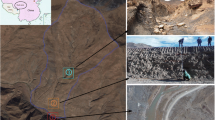Abstract
As one weak topic in research of debris flow, abrasion of debris flow shortens obviously application life of control structure composed of concrete. High-speed drainage structure, one of the most effective techniques to control giant debris flow disaster, has shortened one-third application life due to abrasion by debris flow. Based on velocity calculation method founded by two-phase theory, research of abrasion mechanism of debris flow to high-speed drainage structure was made. The mechanism includes both abrasion mechanism of homogeneous sizing and shearing mechanism of particle of debris flow to high-speed drainage trough structure. Further abrasion equations of both sizing and particle were established by Newton movement theory of debris flow. And abrasion amount formula of the high-speed drainage trough structure is set up by dimensional analysis. Amount to calculating in the formula is consistent with testing data in-situ, which is valuable in design of high-speed drainage structure.
Similar content being viewed by others
References
TANG Bang-xing, ZHANG Shu-cheng. Researches of debris flow[J].Journal of the Chinese Academy of Sciences, 1992,(2): 119–123. (in Chinese)
DU Rong-huan, LI Hong-lian, TANG Bang-xing,et al.. Research on debris flow for thirty years in China[J].Journal of Natural Disasters, 1995,4(1): 64–73. (in Chinese)
ZHANG Shu-cheng. Review of debris flow studies[J].Advences in Mechanics, 1989,19(3): 365–375. (in Chinese)
WU Ji-shan.Observation Studies of Jiang-Jiagou Debris Flow in Yunnan Province[M]. Beijing: Science Press, 1990, 78–92. (in Chinese)
ZHOU Bi-fan, LI De-ji, LUO De-fu,et al..Guiding of Prevention and Control of Debris Flow[M]. Beijing: Science Press, 1991, 65–70. (in Chinese)
WANG Ji-kang.Techniques of Prevention and Control of Debris Flow[M]. Beijing: China Railway Press, 1996, 37–100. (in Chinese)
WU Ji-shan, TIAN Lian-quan, TANG Zhi-cheng,et al.Debris Flow and Its Synthetical Control[M]. Beijing: Science Press, 1993, 10–28. (in Chinese)
CHEN Hong-kai. Researches on integral model both anti-damage roadbed design and control of valley-shaped debris flow with impact and deposit[R].Important Science Fund of the Communications Ministry, 2003, 82–98. (in Chinese)
CHIEN Ning, WAN Zhao-hui.Mechanics of Sedimemt Transportation[M]. Virginia: ASCE Press, 1998, 360–367.
ZHANG Yuan-jun, WANG Hui-yu, ZHANG Zheng-peng,et al. Dynamics of Two-Phases Fluid[M]. Beijing: Beijing Aeronautical Engineering Institute Press, 1987, 17–90 (in Chinese)
CHEN Ji-hua. Abrasion technique review of concrete by high-speed water[J].Construction of Hydraulic and Hydroelectric Engineering, 1994, (4): 27–30 (in Chinese)
LI Xue-jun. The mechanism of abrasion and material anti-abrasion[J].Water Resources & Water Engineering, 1996,7(3): 39–46. (in Chinese)
YIN Yan-guo, HU Xian-guo, CUI De-mi,et al. Approach on abrasion of hydraulic concrete by high-speed water[J].China Concrete and Cement Products, 1999, (3): 14–16. (in Chinese)
HUANG Xi-bin, YUAN Yin-zhong, WANG Shi-xia. Analysis of abrasion of wall material by high-velocity sediment-laden and aerated flow[J].Journal of Hohai University, 2000,28(2): 27–31. (in Chinese)
YIN Yan-guo, HU Xian-guo, CUI De-mi,et al. Water behaviors of hydraulic concrete impacted by water jet with sand at little angle[J].Tribology, 2001,21(3): 126–130. (in Chinese)
YIN Yan-guo, ZHU Yuna-ji, HU Xian-guo. Study on method of erosion-wear experiment of hydraulic concrete[J].Techniques of Hydraulic and Hydroelectric Engineering, 2001,32(3): 15–18. (in Chinese)
NI Jin-ren, HUANG Xiang-jiang. Research on movement features of two-phases fluid both solid and liquid with thick concentration[J].Hydraulic Journal, 2002, (7): 8–15. (in Chinese)
HAI Cao, LI Yin-bo, LIN Xin-song.Adhesion and Surface Adhesion and Coasting Techniques [M]. Beijing: Chemistry Industry Press, 1996, 80–85. (in Chinese)
Author information
Authors and Affiliations
Corresponding author
Additional information
Communicated by DAI Shi-qian
Foundation items: the Key Science Fund of the Communications Ministry (95060233); the Talent Fund of the Communications Ministry (95050508); the National Key Fund of the 10th Five Year of China (2001BA604A023)
Biography: CHEN Hong-kai (1964∼)
Rights and permissions
About this article
Cite this article
Hong-kai, C., Hong-mei, T. & Si-fei, W. Research on abrasion of debris flow to high-speed drainage structure. Appl Math Mech 25, 1257–1264 (2004). https://doi.org/10.1007/BF02438281
Received:
Revised:
Issue Date:
DOI: https://doi.org/10.1007/BF02438281



